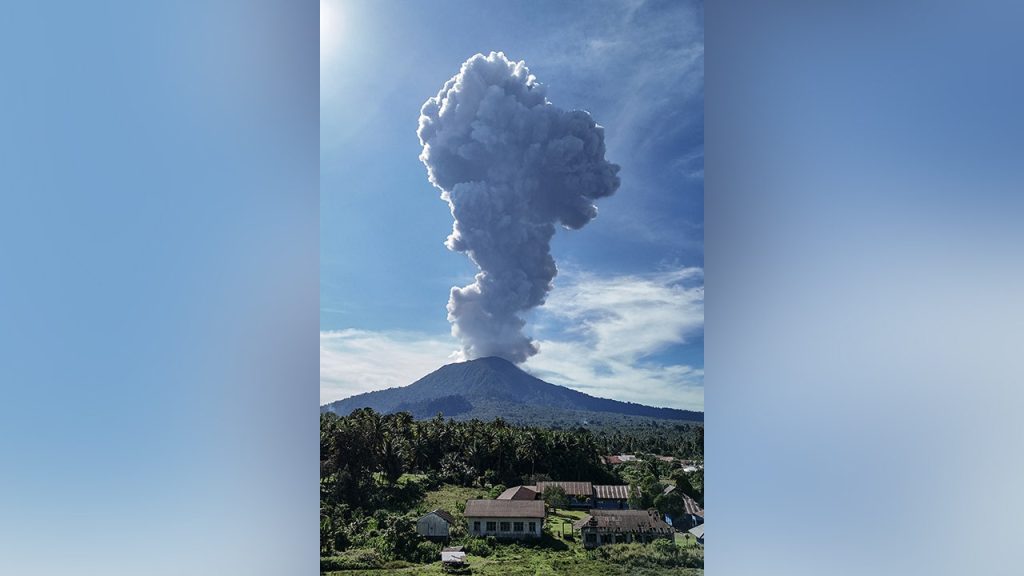Indonesian authorities recently evacuated residents of seven villages within a four-mile radius of Mount Ibu volcano on the remote island of Halmahera in Indonesia. The volcano erupted and spewed ash about 2.5 miles into the sky, turning the sky into a spectacle of gray ash with flashes of purple lightning. A joint team of police, military, and search and rescue services assisted in the evacuation of residents from surrounding villages. Authorities recommended evacuating a seven-kilometer radius around the volcano, though the exact number of people moved was not specified. Residents were taken to emergency tents for shelter as the volcano continued to erupt.
Mount Ibu had erupted previously on May 10 before erupting again last Monday. The eruptions led to the Center for Volcanology and Geological Hazard Mitigation raising the alert level for the volcano from 2 to 3, the second-highest level. Officials warned residents and tourists to stay at least three miles away from the volcano’s crater. More than 13,000 people live within the 3-mile radius on the northern side of the crater. Mount Ibu is a 4,347-foot volcano located on the northwest coast of the remote island of Halmahera. Indonesia, home to 120 active volcanoes, is prone to volcanic activity due to its location along the Ring of Fire, a series of seismic fault lines around the Pacific Ocean.
Following several eruptions, the Volcanology and Geological Hazard Mitigation agency raised the alert level for Mount Ibu to the highest level on Thursday. In addition to Mount Ibu, flash floods and “cold lava” from Mount Marapi in West Sumatra province resulted in flooding in nearby districts and the tragic loss of more than 60 lives. The eruption of North Sulawesi’s Ruang volcano prompted authorities to evacuate over 12,000 people from a nearby island. The frequency of volcanic activity in Indonesia underscores the country’s vulnerability to natural disasters.
The Indonesian government has been actively responding to the volcanic activity, with emergency services working to ensure the safety of residents in affected areas. Evacuations have been carried out swiftly and effectively, with assistance provided to vulnerable populations such as the elderly. Authorities have issued warnings and recommendations to prevent further casualties and ensure the well-being of residents and tourists. The ongoing eruptions serve as a reminder of the volatile nature of Indonesia’s geology and the importance of preparedness and risk mitigation measures in addressing natural disasters.
The eruption of Mount Ibu and other recent volcanic activity in Indonesia highlight the country’s complex geological landscape and the challenges posed by living in such a seismically active region. The Ring of Fire, a horseshoe-shaped zone of volcanic activity around the Pacific Ocean, makes Indonesia particularly susceptible to eruptions and earthquakes. With millions of people residing near active volcanoes, the Indonesian government faces the ongoing task of monitoring and responding to volcanic threats while also preparing communities for potential disasters. The coordination between various agencies in responding to volcanic emergencies demonstrates the importance of preparedness and a swift response in safeguarding lives and property in vulnerable areas.
As Indonesia grapples with the aftermath of volcanic eruptions and other natural disasters, the government continues to prioritize disaster preparedness and response efforts. The recent evacuations and alerts issued in response to volcanic activity underscore the need for proactive measures to protect communities from the impact of natural disasters. By raising awareness, implementing early warning systems, and coordinating emergency responses, the Indonesian authorities aim to mitigate the risks posed by volcanic eruptions and safeguard the well-being of residents in vulnerable regions. The ongoing monitoring of volcanic activity and preventative measures taken by the government reflect a commitment to minimizing the potential impact of natural disasters on the population.


